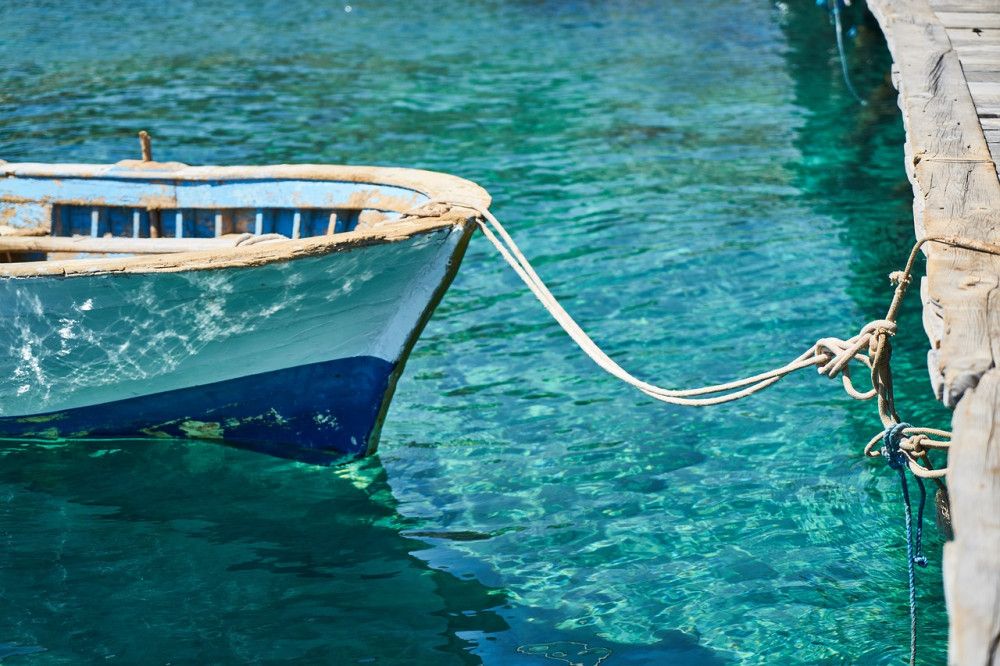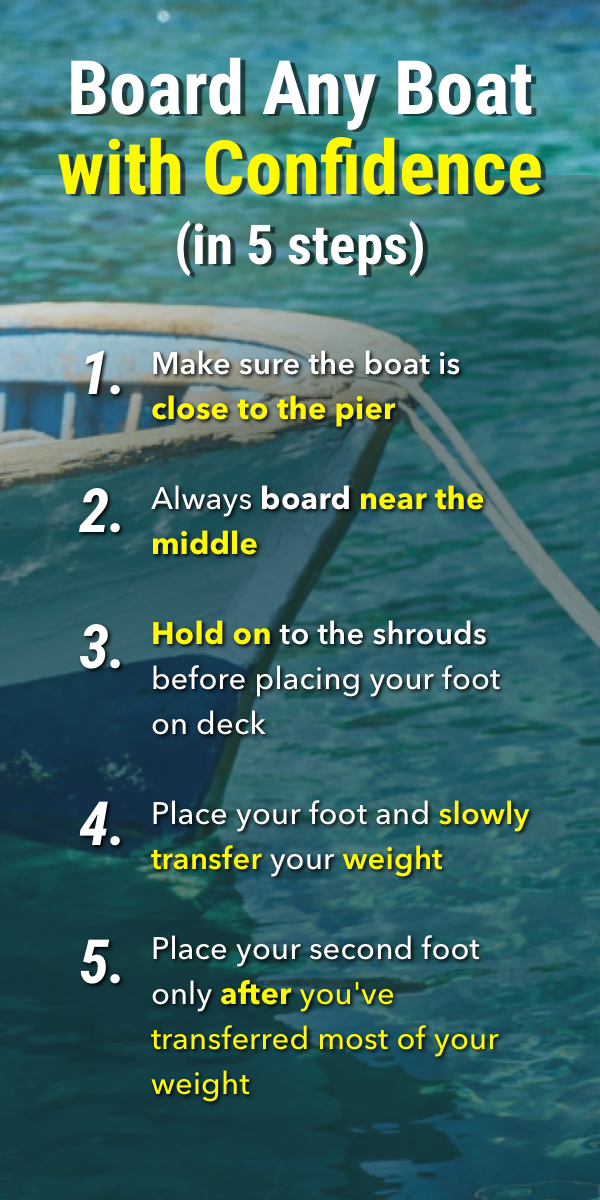How to Board a Boat With Confidence (in 5 Steps)
I remember when I first boarded a boat - it wasn't pretty. It can seem like a super simple thing, but knowing how to board a boat like a pro is actually really helpful. In this article I'll tell you how to do it safely.
How do you board a boat safely?
- Make sure the boat is close to the pier
- Always board near the middle
- Hold on to the shrouds before placing your foot on deck
- Place your foot and slowly transfer your weight
- Place your second foot only after you've transferred most of your weight
This will get you onboard safely every single time. I'll explain each step more in-depth below. There's also a bonus step - read on to find out what it is.

The 5 Boarding Steps Explained
I want to get something off my chest. It's not stupid to Google 'how to board a boat'. I searched it myself one time, because I was too ashamed to ask the helmsman, and I've stumbled around a lot since then - every time I got on board. That actually was stupid, because it can get really dangerous real quick. So I decided to do the research and find the best way.
I'm glad that I did, because now I feel confident when I step on deck, and that confidence translates in my attitude while I'm on it. It sounds stupid, but it helps to become a better sailor. It's a small step for a man, but it's the first.
If you follow these steps, you will never be in harm's way. It's practically fail-safe, so it's worth it to know them by heart. Here are the steps explained in more detail:
0. Ask permission to board
This is more of a nicety, but it actually helps you with safety. Boat etiquette dictates that you always ask permission to board to the helmsman. You simply state: 'permission to board?'. Then, you wait for the answer. It's nice to let others know you understand the rules of boating. It also gives the skipper time to steady the boat for you - which makes it a lot easier.
1. Make sure the boat is close to the pier
Before you do anything, make sure the boat is close alongside the pier or dock. If you've asked for permission to board, the skipper has probably taken the effort to pull the boat right alongside the pier.
If not, wait for him or her to do so. You never want to have to stretch or jump. This could make you lose your balance, with potentially very dangerous consequences. Wait for the boat to be close enough so you can step on deck without any effort, stretching, or jumping.
2. Always board near the middle
Unless the captain says otherwise (and gives you a good reason not to), you should always board the boat near the middle. Here the boat rocks the least when you place your weight on it, making it easier to keep balance.
3. Hold on to the shrouds before placing your foot on deck
Shrouds are the lines that run alongside the mast to the deck. These mostly are steel wires, and they are used to support the mast - so they are incredibly strong. Always make sure you first hold on to the shrouds before even thinking of placing your foot on deck. If there are no shrouds, hold on to any lifelines, railing, or the boat itself.
It's a bit like climbing: you always want three points of contact. Make sure you grab on before moving your first foot.
4. Place your foot and slowly transfer your weight
The first time you board a boat can be uncomfortable if you're not prepared. Boarding a boat can catch you by surprise. It did with me: it's a funny feeling. When you place any weight on it, it starts to wobble and rock. The smaller the boat, the more it will react to your weight.
The way to do it is by placing your foot first without putting any weight on it. Imagine you're stepping onto a patch of ice. Only after you have a firm grip, you slowly transfer your weight into your foot. Make sure you steer your weight downward - into your foot - and not forward. You don't want to slip.
Also, make sure you keep some weight in your back leg.
5. Place your second foot only after you've transferred most of your weight
After your first foot is firmly in place, you can begin to move your on-shore foot. Only do so after you've transferred most of your weight into your front foot. All this time hold on to the shrouds.
If the boat has lifelines running along its sides, make sure to slowly step over them.
Stepping Into the Hull
You're on the boat. Now you have to step into the hull. The deck is higher than the cockpit. On smaller boats, the deck usually is nothing more than an edge and that runs around the hull.
When you step into the hull, the boat will rock heavily. To prevent from tipping over and removing yourself from the boat just as quick as you got on it, follow these steps:
- make sure to step into the middle, near the center-line
- use the same weight transition as you've just used boarding - it's still a sheet of ice
- keep a low center of gravity - don't step forward into the hull, but downward
- don't lean forward when you step into the hull - it's better to lean back a little.
Why Does All Of This Matter?
Well, you want to get this right and get of to a good start. Knowing each step by heart, and why you perform each action helps you to build a routine. Having a routine for getting on board safely helps to build your confidence as a sailor and a crew member. It also helps to grow the confidence others have in you, which is important.
Also, on a boat, there's one simple rule: safety first. Boarding this way consistently keeps you safe - after a while, you don't have to think about it and that's a good thing.
What Happens If You Fail?
If you fail, you could fall between the ship and the shore. That can be very frightening, and potentially very dangerous. Especially with larger ships - I don't want to think about it. The Dutch have a saying: 'tussen het wal en het schip raken' - which translates roughly to: 'to fall between two stools'. You get the point. It's trouble and you don't want to be there.
Or this could happen:
Other Tips on Boarding
Loading the boat - Always load the boat with any provisions after one person has already boarded the boat. Simply hand down any luggage. If you're alone, just leave the provisions on the pier until you are safely on board. Then grab the provisions.
Helping others - Help to keep the boat steady while others are boarding, this really helps them out a lot. If you've never boarded a boat before, you can ask others to do the same for you. It's fine to ask for help, especially on a boat. It's important to be a team and have each other's backs.
Pushing off the boat - If you have to help with pushing off the boat, simply remember this: untie the bowline (front line) first, and push off the bow first. This allows the helmsman to have control over the rudder. Always wait for the helmsman's command.
How To Get Off The Boat
Now you know how to board, getting off is easy. You simply reverse the steps. It's easier to get off since you step onto solid land. But doing it slowly and in a controlled way will help to reduce the rocking of the boat, and the others will thank you for it.
If you're the first to get off, you need to rig a breast line (the front line). If you're not sure how to tie it, that's fine. Simply hold it until someone who does can show you.
Related Questions
How to get into a boat from the water? Use a ladder to get into a boat from the water easily. There are special boating ladders available, but you could also create a simple ladder yourself. Tie a rope with a loop to your traveler and use it to place your foot in.
Did you find the answer to your specific question?
👍 6 👎 2

Comments
Adam Begley
Dear Shawn,
Thanks for making this post and reminding boaters of all skills to keep Safety at the top of their minds while boating.
I own and operate a business called, “HANDICAPTAIN.COM” and we sell and install, state of the art and patented, “Handicapped Boat Access Solutions” to help disabled folks to Safely get On and Off their Boats.
Because I see your intentions are close to the goals my business has, I would like to invite you to become associated with us on Facebook.
If you like what we are doing and want to help our cause, please do us and the people who need us out there a favor and Follow US and Like Us on Our Handicaptain Facebook Business Page At ———- >
https://www.facebook.com/profile.php?id=61552128509897
Thanks you Sincerely,
Adam Begley - President
Handicaptain Barrier Free Boating
Phone: 231-256-2117
Email: handicaptain@charter.net
Website: handicaptain.com
Leave a comment